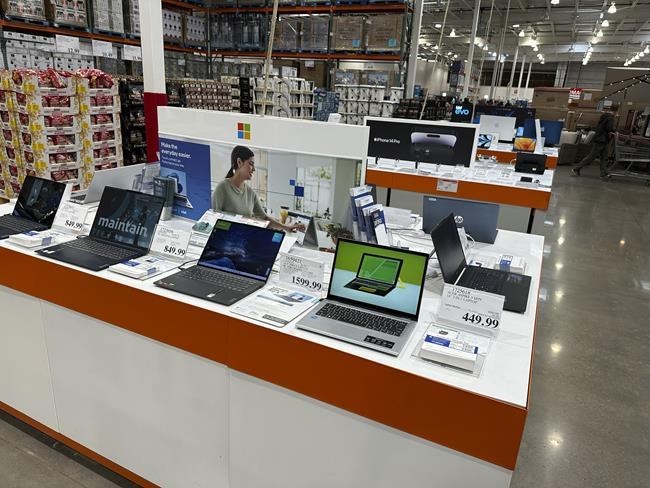Amanda Round’s parents splurged on a high school graduation present for her: a $3,000 Microsoft Book 3 laptop.
With such a high price tag, Round’s mom made sure to show the store her daughter’s McMaster University acceptance letter, so she could get the approximately $500 student discount. Round, now an incoming fourth-year student in McMaster’s integrated science program, advises other students to pull the same move as her mom.
“I don't think I've ever paid full price for any computer,” Round says. “If there's not a back-to-school discount, there’s an education discount.”
Laptop prices range from $300 to $3,000, according to Toronto-based tech consultant Avery Swartz. But now is a good time to buy.
“August is the best time of year to buy a laptop because it's when all the deals are on,” she adds.
Swartz believes the most important questions that students ask themselves before even beginning to research laptops is: What am I using this for? And how much money am I (or my parents) willing to pay?
Round did this before she decided on the Microsoft Book 3 (which is now discontinued). Round knew that she wanted a lightweight laptop with a surface to draw equations and diagrams in her classes, while also being able to run intensive coding programs. The Microsoft Book 3 is a “2-in-1 laptop,” which means that it has the abilities of both a laptop and a tablet (which has that drawable surface), so it was perfect for her.
Round also knew that she would need to run heavy computing power programs for her classes, like Geographic Information Systems (GIS). So she would need a laptop with more random access memory (RAM) for this. Round’s parents even paid extra for more RAM and memory on her laptop (which was included in the final $3,000 price tag).
“This is going to sound silly, but The Sims and Minecraft is a good gauge [for computing power],” Round says. “I have to use GIS in my program and I think that takes less computing power then what you'd need to run the Sims properly."
Swartz describes RAM as “what allows a computer to do multiple things at multiple times.” She flags it as an important tech spec for students. A good way to discover the RAM that students need for their program is to ask the program’s administration. Many programs’ websites provide laptop recommendations.
The website for the computer science program at Dalhousie University has a list of several laptops which would work for its classes. Once students know which model they’re buying, the faculty’s own unit systems administrator Chris Maxwell (who also runs the tech help desk), advises students to think about the value of a warranty.
“If you like sitting with your laptop in your lap while you're drinking beer, you may not want to invest in something with a lot of warranty,” he says. “Because when you dump the beer on the laptop, they're not going to honour the warranty.”
But even beer-ready laptops run at least a couple hundred dollars. Though tablets are a viable alternative for students who are just writing papers and using the internet for research, both Round and Swartz weren’t keen on them.
“A tablet is not a laptop,” Swartz says. “It is its own thing, that's why it's called something different.”
The issue is that students no longer have the option of working without a laptop. Many high schools and post-secondary programs have kept online components from the pandemic, even as in-person classes resume.
“I've literally never had a submission that was paper,” Round says.
Round encourages students to embrace technology, especially in regards to taking notes. She feels that the benefits of digital notes outweigh those of hand-written ones.
“I started my first month at school with paper notes, because I was like, ‘I'm going to be Jane Austen,’” she says. “In the first month [of school], you could have a binder of notes already. It's a lot to carry around. It gets disorganized really quickly. It can get messy, and it's not accessible.”
If you discover that the laptop you need for school runs out of your price range, Swartz recommends buying a certified refurbished laptop. This is a used laptop that has been repaired and cleared of all its previous programs and information, so it’s often a bit cheaper.
The major issue with refurbished laptops is that they may not last long and you don’t know what you’re getting. Swartz emphasizes the importance of asking a lot of questions before purchasing a refurbished laptop, such as: How old is the laptop? What condition was it in when it was refurbished? Is there a refurbishment guarantee?
Another way Swartz recommends saving money long-term is to invest in a laptop that will last you three to five years, which will likely be the length of your high school or post-secondary career. She says these laptops tend to cost $700 to $800.
“I would rather see you spend a little bit more … as opposed to spending a little bit less on a device that after 18 months, you’re going to be like, ‘This is a piece of garbage–literally garbage, because they tend to end up in landfills–and then you're just going to have to go out and spend again,” she says.
This report by The Canadian Press was first published August 1, 2023.
Sabina Wex, The Canadian Press



